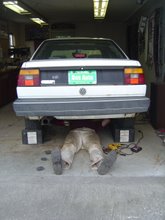There was a mild storm yesterday that dropped about six inches of snow on the county. I was shoveling and clearing snow, when, for some reason I stopped and put my hand on the hood of the white Jetta. As soon as I touched it I felt a rush of emotions. I know that this car is an inanimate object but for a second I felt the same sort of affection toward it that I might feel toward my dog. Then it hit me. This car, like a dog, is a sort of creature in the sense that it was created by a creator. The car is not alive, obviously, it does not meet the requirements necessary to be considered animal life. But it is a creature, a sort of proto-animal, that we humans have created as an extension of our own body. I say extension, because the car enhances our mobility and mobility is a natural asset of the typical two-legged human.
There are other proto-animals. The internet, unlike the car which is an extension of our legs, is an extension of our mind. Like the car, though, the internet enhances a natural human asset; our ability to store and process information. No, the internet is not self-aware, but it is a network that allows the transfer of stored data from locality to locality. Like our brains this transfer is accomplished by firing electronic impulses through a host of networked nodes. This network of connections is flexible. If there is an overload or a damaged node then the information can be re-routed around the obstruction in order to maintain the same destination.
For a long time I have entertained the notion that people are not much more than sophisticated machines, albeit thinking and feeling machines that run through a growth cycle before declining and dying. We live in a physical world which necessitates our ability to perform work on the environment around us. Work is the application of force to move mass over distance and a machine is a device that performs or assists in performing work. It’s basic physics. Guess what you’re doing right now. You’re moving electrons in your brain, electrons have mass, therefore your brain is a machine performing work.
Obviously, there is more going on in most brains, George W’s aside, than the transfer of electrons from place A to place B. This is where things get a bit tricky. It is apparent that our brains are superior to the brains of the other animals on our planet. However, even your typical cat demonstrates the ability to process and act on gathered information. For example, one of my cats has figured out how to open certain doors in my house. My house is old, built in 1880, and some of the doors don’t latch tight. At first, it was by accident. This particular cat was upset about being shutout of the bathroom while I was showering. I guess it missed me. So, it started clawing at the door and happened to hook a claw on the door’s bottom edge. When it pulled its paw back the door opened. Here we see instinct leading to discovery. Next point, we keep the cats’ food in a bag inside a closet with a closed door. If you leave the bag out the cats will feed themselves and get very fat. This same cat applied its newly discovered tactic to the closet door and gained access to the food. We have since added a latch for extra security. This cat has demonstrated consciousness. The cat, having in mind the goal of acquiring extra food, considered the problem of the closed, closet door by drawing on its past experience with the bathroom door. Realizing the similarities of the two situations, the cat decided to solve the problem by applying the tactic used on the bathroom door to the closet door. Now, this is a simple thought process. I don’t think I have to worry about my cat schooling me on Plato’s Allegory of the Cave, but neither have I been sleeping so well since this all transpired.
I can not claim to legitimately understand the mind or consciousness, nor can anyone else. So, where am I going with this? The cat is alive and capable of thinking to a certain degree. The cat is not an extension of our own being in the way that a car or the internet is. Yet, this autonomous creature, like us, is a machine. At this point, we are still pulling the levers behind the machinery we build. However, we are always working to create more sophisticated machines. The cars built today have sensors to modulate braking when conditions are slippery or if a potential roll-over is detected. There are plans to equip future vehicles with sensors that will detect impending collisions with other vehicles. The sensors will allow the car’s computer to engage the brake at the proper rate to avoid the accident. At this point, the data is processed by a pre-programmed computer. I have to ask myself, however, how long will it be before these systems are able to make their own adjustments based on data gathered during past experiences?
Saturday, March 3, 2007
Subscribe to:
Post Comments (Atom)

No comments:
Post a Comment